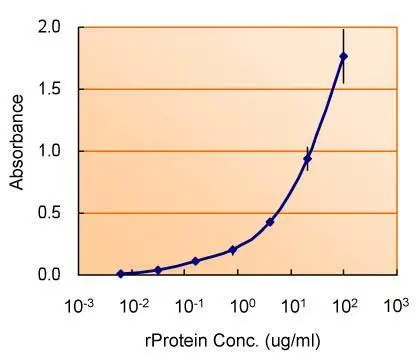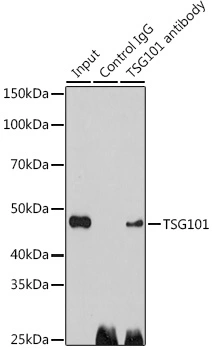
ELISA detection of TSG101 using GTX118736 for capture at a concentration of 5 microg/mL and GTX70255 for detection at a concentration of 1.5 microg/mL. The HRP-conjugated anti-mouse IgG antibody (GTX26789) was diluted at1:6,000-1:30,000 and used to detect the primary antibody.
TSG101 ELISA Pair
GTX500018
ApplicationsELISA
Product group Antibodies
TargetTSG101
Overview
- SupplierGeneTex
- Product NameTSG101 ELISA Pair - TSG101 antibody Pair
- Delivery Days Customer9
- Application Supplier NoteWe recommend using the capture antibody at a concentration of 5microg/mL and the detection antibody at a concentration of 1.5microg/mL. Optimal dilutions should be determined experimentally by the researcher.
- ApplicationsELISA
- CertificationResearch Use Only
- Gene ID7251
- Target nameTSG101
- Target descriptiontumor susceptibility 101
- Target synonymsESCRT-I complex subunit TSG101; TSG10; tumor susceptibility gene 10; tumor susceptibility gene 101; tumor susceptibility gene 101 protein; tumor susceptibility protein; VPS23
- Scientific DescriptionThe protein encoded by this gene belongs to a group of apparently inactive homologs of ubiquitin-conjugating enzymes. The gene product contains a coiled-coil domain that interacts with stathmin, a cytosolic phosphoprotein implicated in tumorigenesis. The protein may play a role in cell growth and differentiation and act as a negative growth regulator. In vitro steady-state expression of this tumor susceptibility gene appears to be important for maintenance of genomic stability and cell cycle regulation. Mutations and alternative splicing in this gene occur in high frequency in breast cancer and suggest that defects occur during breast cancer tumorigenesis and/or progression. [provided by RefSeq]
- Storage Instruction-20°C or -80°C,2°C to 8°C
- UNSPSC12352203




